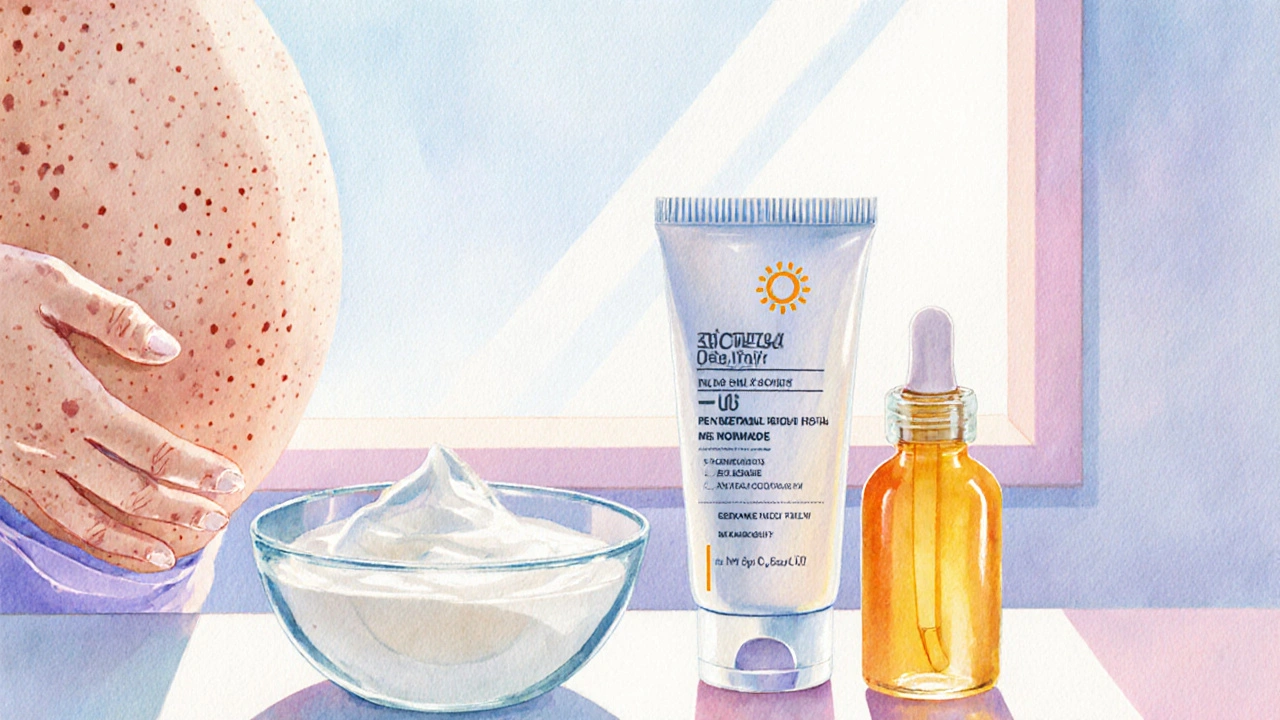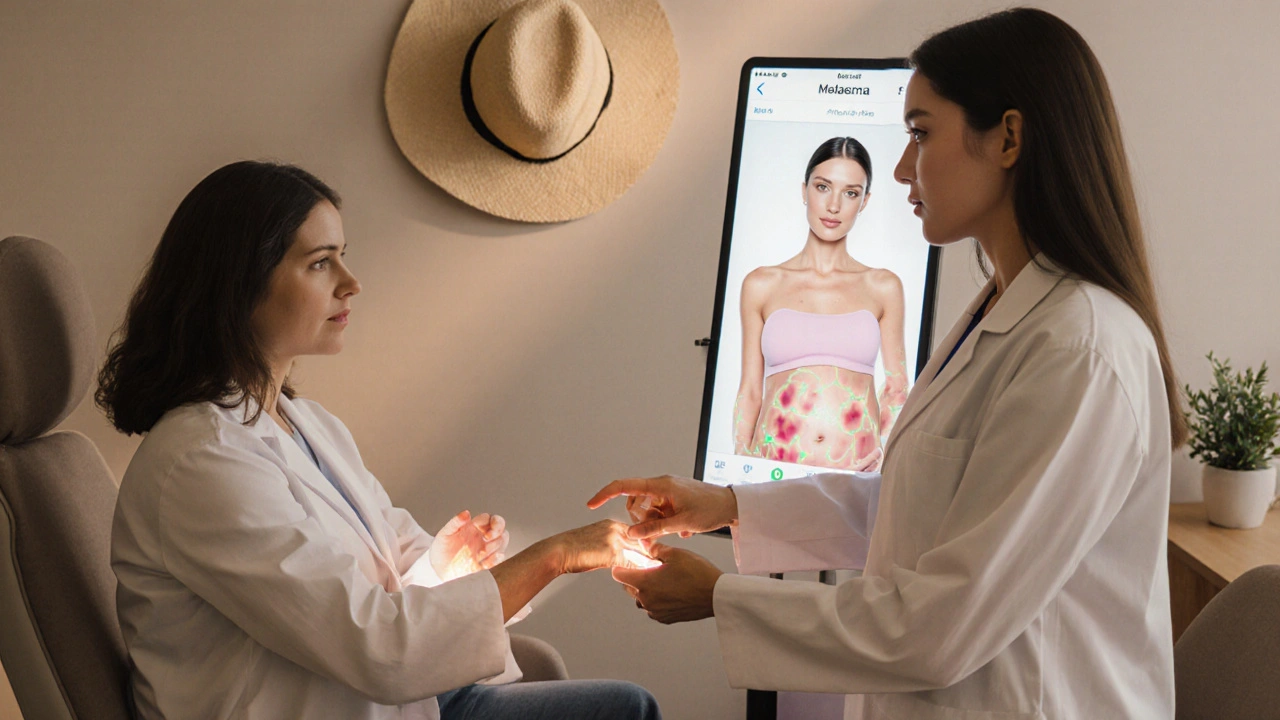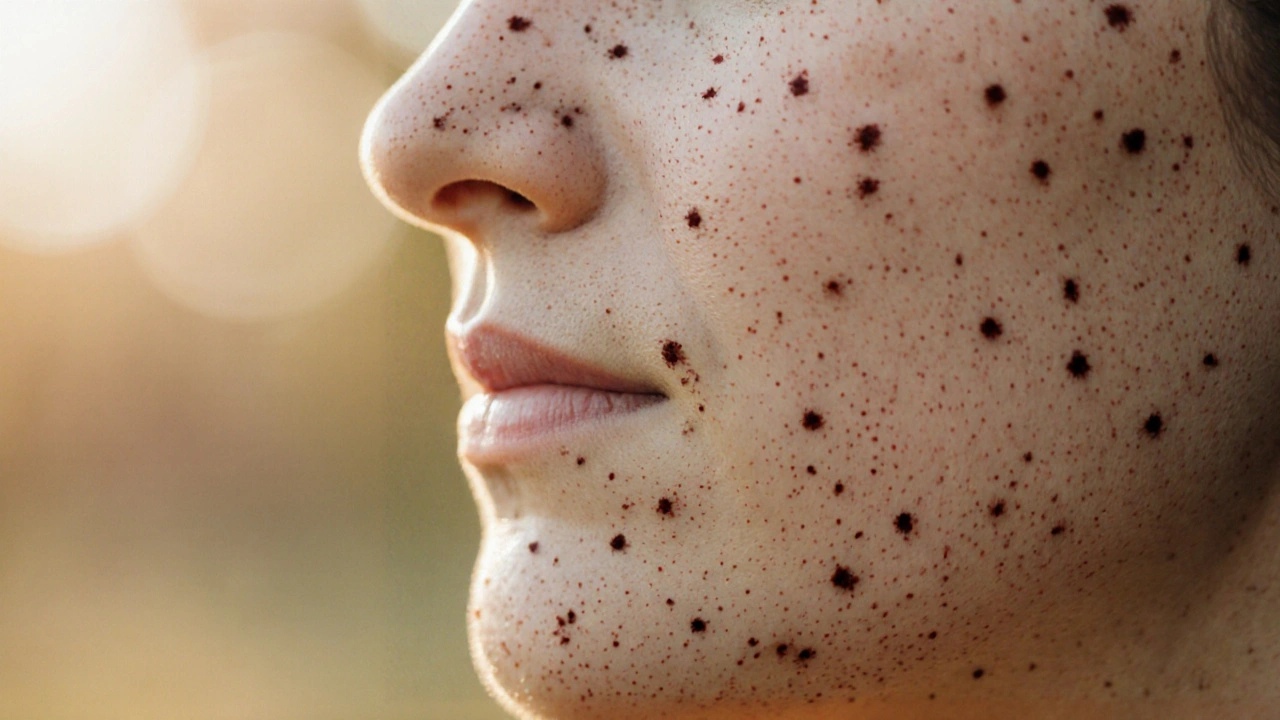Pregnancy Sun Protection Calculator
Safe Sun Protection Guide
During pregnancy, hormonal changes increase your skin's sensitivity to UV rays. This calculator helps you determine the right amount of sunscreen needed for effective protection while avoiding over-application.
Calculate Your Sunscreen Needs
Your Sun Protection Plan
Enter your details above to see your personalized sun protection recommendations.
Sun Protection Tips for Pregnancy
• Apply sunscreen 15-30 minutes before sun exposure
• Reapply every 2 hours or immediately after sweating/swimming
• Use at least 1/4 teaspoon for your face and neck
• Mineral sunscreens (zinc oxide/titanium dioxide) are safer during pregnancy
• Don't skip sunscreen on cloudy days (UV rays penetrate clouds)
• Wear wide-brimmed hats and UV-blocking clothing for added protection
Quick Takeaways
- Hormonal spikes can darken freckles and trigger melasma.
- Use a broad‑spectrum mineral sunscreen daily, reapplying every two hours outdoors.
- Gentle, fragrance‑free moisturizers with ceramides keep the skin barrier strong.
- VitaminC serums help lighten existing spots without harming the baby.
- Visit a dermatologist if new dark patches spread quickly or cause itching.
What’s really happening to freckled skin during pregnancy?
When you’re expecting, pregnancy is a time when the body produces extra hormones to support the growing baby. The most influential are estrogen and progesterone, which rise dramatically in the first trimester. These hormones boost melanin production, the pigment that gives freckles their color.
For people with naturally freckled skin, that melanin surge can make freckles appear darker, larger, or even merge into larger patches. The change is called hyperpigmentation an overall darkening of the skin in response to hormonal shifts. It’s nothing dangerous, but it can be cosmetically upsetting.
Typical pigmentation challenges: melasma and beyond
The most common pigment issue in pregnancy is melasma a brownish, irregular patch that usually shows up on the cheeks, forehead, or upper lip. Though melasma can affect anyone, people with freckles often notice it sooner because their skin already has a lot of melanin.
Melasma isn’t a disease, but it signals that the skin’s pigment cells are overactive. The good news? It usually fades after delivery as hormone levels normalize, but you can soften its appearance now with smart skincare.

Building a pregnancy‑safe daily routine
Start with a gentle cleanser that respects the skin barrier. Look for formulas without sulfates or strong fragrances. Follow with three core steps: sunscreen, moisturizer, and an antioxidant serum.
- Sunscreen: The single most powerful tool against darkening freckles.
- Moisturizer: Keeps the barrier intact, preventing irritation that can worsen pigment.
- Antioxidant serum: VitaminC is safe, brightens, and supports collagen.
Choosing the right sun protection
Not all sunscreens are equal, especially when you’re pregnant. Chemical filters can sometimes cause irritation, so many experts prefer mineral (physical) options that sit on top of the skin and reflect UV rays.
| Feature | Mineral (Physical) | Chemical (Organic) |
|---|---|---|
| Active Ingredients | Zinc oxide, titanium dioxide | Octinoxate, avobenzone, homosalate |
| Safety in Pregnancy | Generally recognized as safe | Mixed evidence; some prefer to avoid |
| Texture | May leave a slight white cast | Usually transparent |
| Broad‑Spectrum Coverage | Offers UVA & UVB protection | Effective when formulated correctly |
| Typical Price (AU$) | 15‑30 | 12‑25 |
Pick a SPF 30‑50 mineral sunscreen, apply it every morning, and reapply after swimming or sweating. Even on cloudy days, UV‑A penetrates, so don’t skip it.
Moisturizers that won’t aggravate freckles
Pregnancy can make the skin extra sensitive, so opt for fragrance‑free, hypoallergenic moisturizers. Look for ingredients that reinforce the barrier:
- Ceramides: restore lipid layers.
- Niacinamide: reduces inflammation and fades dark spots.
- Hyaluronic acid: pulls moisture without oiliness.
A good example is a thick, dairy‑free cream with 3% ceramides and 2% niacinamide. Apply after sunscreen to lock in hydration.

Spot‑light on vitaminC and other safe actives
VitaminC is a powerhouse antioxidant that inhibits melanin production and protects against free‑radical damage. A 10‑15% L‑ascorbic acid serum is safe throughout pregnancy and can be used once or twice daily.
Other gentle actives that dermatologists often recommend for melasma‑prone skin during pregnancy include:
- Azelaic acid (15%): anti‑inflammatory and brightening.
- Niacinamide (5%): improves barrier and fades discoloration.
- Licorice root extract: natural tyrosinase inhibitor.
Avoid retinoids, hydroquinone, and high‑strength acids, as they lack safety data for the developing baby.
Lifestyle habits that support even skin tone
Skincare works best when paired with healthy habits.
- Balanced diet: foods rich in antioxidants-berries, leafy greens, and nuts-help skin recover.
- Hydration: aim for 2‑3 liters of water daily to keep cells plump.
- Sleep: 7‑9 hours supports skin regeneration.
- Stress management: cortisol can worsen pigmentation, so try prenatal yoga or meditation.
- Limit sun exposure: wear wide‑brim hats and UV‑blocking clothing when outdoors.
When to see a dermatologist
If you notice any of the following, schedule a visit with a dermatologist a skin specialist trained to treat pigment disorders safely:
- New dark patches spreading rapidly.
- Itching, scaling, or pain around freckles.
- Freckles that don’t fade after delivery.
- Desire for professional‑grade treatments (e.g., low‑dose laser, chemical peels) that are pregnancy‑approved.
During the first trimester, many doctors prefer to monitor and use only topical, non‑systemic options. After the second trimester, more treatments become available under close supervision.
Frequently Asked Questions
Can I use existing freckle‑removal creams while pregnant?
Most over‑the‑counter fade‑cream formulas contain hydroquinone or retinoids, which are not recommended during pregnancy. Stick to vitaminC, niacinamide, and azelaic acid instead.
Is it safe to get a professional facial for pigment issues?
Gentle hydrating facials are fine, but avoid deep chemical peels or microdermabrasion in the first trimester. Ask your practitioner to use only pregnancy‑approved products.
How long does melasma usually last after delivery?
For most people, melasma begins to fade within 3‑6 months postpartum as estrogen and progesterone levels drop. Consistent sunscreen use can speed up the process.
Should I increase my sunscreen SPF during pregnancy?
SPF 30 is the minimum, but SPF 50 provides extra protection for the heightened melanin response. Reapply every two hours or after swimming.
Are there any foods that worsen freckle darkening?
Highly processed sugars and excessive caffeine can increase inflammation, potentially aggravating pigment. Focus on whole foods and stay hydrated.

Lawrence D. Law
In adherence to dermatological best practices, one must apply a mineral sunscreen containing zinc oxide or titanium dioxide at a minimum of SPF 30; this recommendation is substantiated by peer‑reviewed photoprotection studies, and it is imperative to reapply bi‑hourly when exposed to solar radiation, irrespective of cloud cover, to mitigate the hormonally induced hyperpigmentation observed during gestation.
Odin Zifer
They don’t tell you the truth about those chemical filters they’re hiding in the tubes they’re part of a global agenda to control our skin health
Marisa Leighton
Congratulations on the wonderful journey of pregnancy! Your skin is about to embark on a spectacular transformation, and the good news is that you can take charge of the radiance you deserve. First, embrace the power of broad‑spectrum mineral sunscreen; think of it as a shield that reflects UV rays before they can trigger melanin overdrive. Second, apply at least a quarter‑teaspoon to your face and neck each morning – the quantity matters more than the brand hype. Third, reapply every two hours, especially after swimming, sweating, or simply strolling under the bright sky. Fourth, pair that sunscreen with a fragrance‑free moisturizer loaded with ceramides, because a fortified barrier is less prone to irritation and pigment flare‑ups. Fifth, sprinkle a vitamin C serum into your routine; this antioxidant not only brightens existing freckles but also curtails new dark spots from forming. Sixth, stay hydrated – aim for 2‑3 liters of water daily to keep your skin cells plump and resilient. Seventh, protect yourself with a wide‑brimmed hat and UV‑blocking clothing; fashion can be functional! Eighth, nourish yourself with antioxidant‑rich foods such as berries, leafy greens, and nuts; nutrition supports skin repair from the inside out. Ninth, get sufficient sleep; those 7‑9 hours each night are when your skin does its nightly rejuvenation. Tenth, manage stress through prenatal yoga or meditation, because cortisol can aggravate pigment issues. Eleventh, avoid retinoids, hydroquinone, and high‑strength acids; their safety data during pregnancy remain inconclusive. Twelfth, if you notice rapid spreading of dark patches or any itching, schedule a dermatologist visit promptly – early intervention is key. Thirteenth, remember that melasma often fades after delivery as hormone levels normalize, but consistent sunscreen use will accelerate that fade. Fourteenth, consider a gentle azelaic acid product (15 %) if you need an extra brightening boost, as it is deemed pregnancy‑safe. Fifteenth, keep a sunscreen diary to track application frequency and any skin changes you observe. Finally, celebrate each small victory – glowing, protected skin is a beautiful tribute to the new life you’re nurturing.
Chelsea Hackbarth
Here’s the quick rundown you asked for 😊: mineral sunscreens are your BFF because they sit on top of the skin and bounce UV rays back, zinc oxide and titanium dioxide are the star ingredients, SPF 30‑50 is the sweet spot for pregnancy, reapply every 2 hours (or after a swim), and don’t forget a vitamin C serum for that extra glow ✨. Also, stay away from any product that lists oxybenzone or octinoxate – those are the ones to watch out for!
Adam Shooter
From a dermatological photoprotection paradigm, the integration of a zinc‑oxide‑based emulsion constitutes a non‑ionic, colloidal barrier that concurrently attenuates UVA/UVB photon penetration; this mechanistic attribute is corroborated by spectrophotometric absorbance coefficients observed in vitro. Moreover, the occlusive matrix enhances transepidermal water loss (TEWL) mitigation, thereby preserving the stratum corneum’s lipid homeostasis – a critical factor during gestational hormonal flux.
Shanmughasundhar Sengeni
Look, the guide is fine but honestly, who has time to measure teaspoons? Just slop on a decent amount and don’t forget to re‑apply if you’re out for a walk. The whole mineral versus chemical thing is overblown – pick something that doesn’t sting your skin.
Christina Burkhardt
Great points on sunscreen quantity! I’d add that keeping a travel‑size tube in your bag can make re‑application less of a hassle, especially when you’re juggling appointments and cravings. Also, a quick pat‑down with a light moisturizer after sunscreen can help lock in the protection without feeling greasy.
liam martin
Ah, the solemn decree of SPF-truly a drama worthy of the ages! One must not merely slather on cream, but perform a ritual, as if the very sun were a fickle lover awaiting obeisance.
Ria Ayu
From a holistic perspective, protecting the skin is as much an act of self‑respect as it is of physical health. The gentle cadence of mindful application reminds us to stay present, even amid the whirlwind of prenatal changes.
maya steele
In accordance with the evidence‑based recommendations, I concur that mineral formulations are preferable during gestation. Should you encounter persistent hyperpigmentation, a consultation with a board‑certified dermatologist is advisable to explore adjunctive therapies that have established safety profiles.
Sharon Lax
The data suggests that the incorporation of ceramides can ameliorate barrier dysfunction, yet practical adherence remains low; perhaps a streamlined regimen would enhance compliance among expectant mothers.
paulette pyla
Oh sure, because reading a dermatologist‑approved label is such a monumental chore-let’s all just wing it with whatever glittery bottle looks cute on our Instagram feed. 🙄
Benjamin Cook
Hey everyone! Remember, sunscreen isn’t just for beach days-apply it before you even step out for a quick grocery run!!! And don’t forget to re‑apply after you’re done sweating in the kitchen!!
Breanne McNitt
Exactly! I keep a mini‑squeeze bottle in my diaper bag so I never miss a re‑apply, even when I’m chasing after a toddler.
Christopher Ellis
The sun is a liar.
Raina Purnama
While the guide is well‑structured, a minor typographical oversight appears in the table header where “Feature” is misspelled as “Feture.” Correcting such errors enhances readability and maintains professional standards.
April Yslava
They don’t want you to know that the SPF numbers are a sham orchestrated by big pharma to keep us dependent on their products. The real protection comes from staying indoors and avoiding the sun altogether, which they conveniently ignore.
Daryl Foran
Honestly, if you’re not measuring your sunscreen with a spoon, you’re probably not taking this seriously enough. The science is clear: precise dosing equals better outcomes.
Rebecca Bissett
Wow… another reminder that sunscreen is essential… even when clouds hide the sun… because apparently UV rays love to sneak around… 🙄